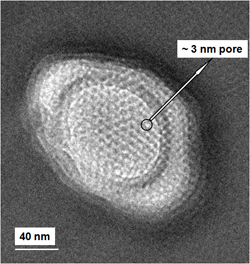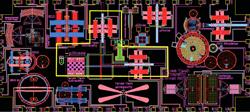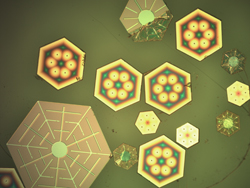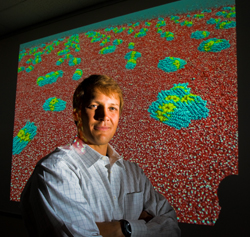Formerly unrealized defect results in clumping and unwanted chemical interactions ALBUQUERQUE, N.M.— It may seem obvious that dunking relatively spherical objects in a sauce — blueberries in melted chocolate, say — will result in an array of completely encapsulated berries. Relying on that concept, fabricators of spherical nanoparticles have similarly dunked their wares in protective […]
Category Archives: Nanotechnology
Newer posts
Kinked nanopores slow DNA passage for easier sequencing
Sandia self-assembly and atomic-layer deposition improve process fivefold ALBUQUERQUE, N.M. — In an innovation critical to improved DNA sequencing, a markedly slower transmission of DNA through nanopores has been achieved by a team led by Sandia National Laboratories researchers. Solid-state nanopores sculpted from silicon dioxide are generally straight, tiny tunnels more than a thousand times […]
Tom Friedmann awarded NASA Exceptional Engineering Achievement Medal
Diamond-like thin film offers hard data for solar models ALBUQUERQUE, N.M. — Sandia National Laboratories researcher Tom Friedmann was awarded NASA’s Exceptional Engineering Achievement Medal (EEAM) at a ceremony June 15 at the Jet Propulsion Laboratory (JPL) in Pasadena, Calif. He received the award for the quality of the diamond-like carbon thin films he contributed […]
Sandia Labs reports first successful integration of a terahertz quantum-cascade laser and diode mixer into a monolithic solid-state transceiver
Improved control of “neglected middle-child” frequency range offers potential benefits ALBUQUERQUE, N.M. — Sandia National Laboratories researchers have taken the first steps toward reducing the size and enhancing the functionality of devices in the terahertz (THz) frequency spectrum. By combining a detector and laser on the same chip to make a compact receiver, the researchers […]

Texas Tech, U of Utah win Sandia microdevice competition
World’s smallest chess set and a microbarbershop win big ALBUQUERQUE, N.M. – The world’s smallest chess board — about the diameter of four human hairs — and a pea-sized microbarbershop were winners in this year’s design contest for, respectively, novel and educational microelectromechanical systems (MEMS), held at Sandia National Laboratories in mid May. The two […]

Sandia paper on steric confinement of proteins published in PNAS journal
LIVERMORE, Calif. — A paper authored by Sandia National Laboratories researchers Jeanne Stachowiak, Carl Hayden and Darryl Sasaki is featured in the April 13 edition of PNAS, the Proceedings of the National Academy of Sciences. The paper, “Steric confinement of proteins on lipid membranes can drive curvature and tubulation,” presents a new scientific understanding about […]

Julia Phillips to speak on solid-state lighting’s contributions to national energy efficiency at AAAS Annual Meeting
SAN DIEGO, Calif. — Solid-state lighting and its potential as a near-term generator of energy efficiencies will be the topic of a presentation by Julia Phillips, director of the Physical, Chemical, and Nano Sciences Center at Sandia National Laboratories, at the 2010 AAAS annual meeting. The meeting runs Feb. 18-22 in San Diego, Calif. In […]

Glitter-sized solar photovoltaics produce competitive results
Adventures in microsolar supported by microelectronics and MEMS techniques ALBUQUERQUE, N.M. — Sandia National Laboratories scientists have developed tiny glitter-sized photovoltaic cells that could revolutionize the way solar energy is collected and used. The tiny cells could turn a person into a walking solar battery charger if they were fastened to flexible substrates molded around […]

Magnetic mixing creates quite a stir
Sandia researcher solves problem of mixing liquids in tiny volumes ALBUQUERQUE, N.M. – Sandia researchers have developed a process that can mix tiny volumes of liquid, even in complicated spaces. Researchers currently use all types of processes to try and create mixing, with only “mixed” success. “In small devices,” says Sandia materials scientist Jim Martin […]

Sandia researchers construct carbon nanotube device that can detect colors of the rainbow
LIVERMORE, Calif. — Researchers at Sandia National Laboratories have created the first carbon nanotube device that can detect the entire visible spectrum of light, a feat that could soon allow scientists to probe single molecule transformations, study how those molecules respond to light, observe how the molecules change shapes, and understand other fundamental interactions between […]
